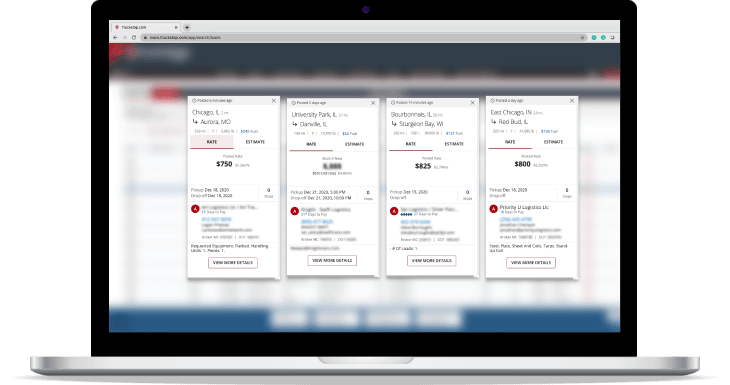Freight Classification: What It Is & How It Affects Shipping Rates

Whether you are operating just one trailer or a fleet of trucks, you’re part of one of this country’s biggest industries.
According to the US Department of Transportation, the U.S. freight market accounts for more than $1.1 trillion of business each year and handles more than 17.7 billion tons of goods. America’s freight haulers help keep the economy going. Despite some pandemic-related hiccups, the freight industry is expected to grow by $170 billion by 2025.
What are you waiting for?
Make more money starting now.
Carriers and brokers provide multiple options for shippers, including full truckload (FTL), less-than-truckload (LTL), and partial truckload (PTL) freight.
- FTL freight gives shippers the exclusive use of a trailer. With cost-per-mile pricing, FTL is the quickest way to ship because carriers don’t have to make multiple stops or fill trucks with freight from other shippers.
- PTL freight is typically used for odd-shaped or other items that don’t fill an entire trailer or truckload. Rates are based on cost per mile in the same way an FTL load is priced. So, carriers can charge the same rate as if they had an entire truckload while only using a portion of the capacity.
- LTL freight also uses only a portion of a trailer’s capacity but is combined with freight from other shippers. With LTL shipments, LTL carriers and brokers want to match compatible loads to maximize capacity and provide the best possible rates. Rates will vary depending on a variety of factors, including freight classification and NMFC codes.
What is freight classification?
Freight classification is a pricing structure table that helps carriers determine the cost for moving freight. The classes from the National Motor Freight Traffic Association, which publishes standard freight classification codes and updates them as often as three times a year. The National Motor Freight Classification (NMFC) codes help shippers, brokers, and carriers more easily determine what’s being shipped and how to set rates appropriately.
What factors determine freight classification?
As a carrier, you need to know how to calculate freight class to set the right rates and optimize your trailers. But what is a freight class based on? It’s based primarily on five factors:
- Freight density
The density is the amount of space your freight will take up on a trailer relative to its weight. The ratio of weight to volume is expressed in per cubic foot (PCF) measurements. - Handling
How difficult goods are to transport and whether they need any special handling will also be a factor in the classification of your freight. If freight is difficult to handle, it may be placed in a higher class. - Stowability
If items are heavy, hazardous, or very large, they can be difficult to stow efficiently or require additional resources to move. Stowability also considers a shipment’s freight size, shape, and ability to be stacked or nested. - Liability
Perishable or fragile items can also increase carrier liability and need temperature-controlled or refrigerated trailers. - Value
How much the commodity is worth also influences overall rates.
Density-based freight classification
When all other factors are similar, density will be the prime driver for a class assignment.
Freight classification codes
Freight classifications make it easier for shippers, carriers, and brokers to calculate rates based on pre-determined NFMC characteristics. A typical NMFC freight class chart might look like the one below.
Class Name | Cost | Examples | Weight Range Per Cubic Foot
Class 50 – Clean Freight
Lowest Cost
Fits on a standard shrink-wrapped 4X4 pallet, very durable
Over 50 lbs
Class 55
Bricks, cement, mortar, hardwood flooring
35-50 pounds
Class 60
Car accessories & car parts
30-35 pounds
Class 65
Car accessories & car parts, bottled beverages, books in boxes
22.5-30 pounds
Class 70
Car accessories & car parts, food items, automobile engines
15 to 22.5 pounds

Class 77.5
Tires, bathroom fixtures
13.5 to 15 pounds
Class 85
Crated machinery, cast iron stoves
12-13.5 pounds
Class 92.5
Computers, monitors, refrigerators
10.5-12 pounds
Class 100
Boat covers, car covers, canvas, wine cases, caskets
9-10.5 pounds
Class 110
Cabinets, framed artwork, table saw
8-9 pounds
Class 125
Small household appliances
7-8 pounds
Class 150
Auto sheet metal parts, bookcases
6-7 pounds
Class 175
Clothing, couches, stuffed furniture
5-6 pounds
Join Our
Trusted Network
Help protect your business with the load board you can rely on.
Class 200
Auto sheet metal parts, aircraft parts, aluminum table, packaged mattresses
4-5 pounds
Class 250
Bamboo furniture, mattress and box spring, plasma TV
3-4 pounds
Class 300
Wooden cabinets, tables, chairs, model boats
2-3 pounds
Class 400
Deer antlers
1-2 pounds
Class 500 – Low Density or High Value
Highest Cost
Bags of gold dust, ping pong balls
Less than 1 lb.
Why freight classification is important for carriers and shippers

For shippers using full truckload shipping (FTL), freight stays onboard the entire transit and does not share trailer space with other shippers. Only one truck and one driver are required regardless of how much space the cargo takes up. Shippers are paying for the entire load.
With LTL, carriers might need to load and unload products multiple times at different hubs and destination points along the route. Because multiple shippers will have loads in the same trailer, what they’re shipping is really important. For example, whether pallets can be stacked, how much they weigh, how fragile they are, and the dimensions make a significant difference in transport and pricing.
Carriers allocate space, and brokers book space based on freight classifications, so it’s important to get it right. When a shipment has been incorrectly classified, it can cause problems for everyone. For example, a carrier expecting to stack multiple pallets might not have enough room if they find out during loading that some items aren’t stackable.
How freight class affects shipping rates
The easier it is to handle and transport materials, the better rates carriers can offer. Items with a lower freight class will be assigned a lower cost per pound. Larger and lighter freight have higher costs per pound.
A 4×4 pallet weighing more than 500 pounds takes up the same space as a palette with only 10 pounds of goods.
To figure out how to determine freight class, it can be helpful to use a freight class calculator, freight class chart, or freight class list.
What’s the difference between freight class and NMFC code?
All commodities will have both a freight class and an MNFC code. The freight class is determined by the 18 freight classes, while the NFMC code details the specific type of commodity being transported. For example, both computers and molded auto parts fall into class 250, but auto parts have an NMFC code of 18430, while computers and monitors have an NMFC code of 116030.
These codes help brokers and carriers understand exactly what types of products are being shipped even when they fall into the same classification.
Use a load board to search for freight.

Using a load board can simplify the entire freight shipping process whether you’re a carrier, broker, or shipper.
Truckstop provides industry-leading load boards for anyone carrying, brokering, or shipping goods.
Load Board for Carriers
Use the Truckstop Load Board for Carriers to find more loads and make more money.
- Access the largest volume of legitimate loads.
- Partner with trustworthy brokers.
- Book loads instantly online.
Load Board for Brokers
Brokers using the Truckstop Load Board for Brokers can find capacity, increase margins, and book loads more quickly.
- Find thousands of trusted carriers.
- Cover loads quickly.
- Uncover hidden capacity.
Load Board for Shippers
Shipper using the Truckstop Load Board for Shippers can streamline operations and move freight faster.
- Simplify the shipping process.
- Work with the best partners in the business.
- Save money.
Get a free demo of the best load board in the industry and learn how Truckstop can make your life easier and more profitable.
Topics:
Get helpful content delivered to your inbox.
Sign up today.
Find high-quality loads fast, get higher rates on every haul, and access tools that make your job easier at every turn.






